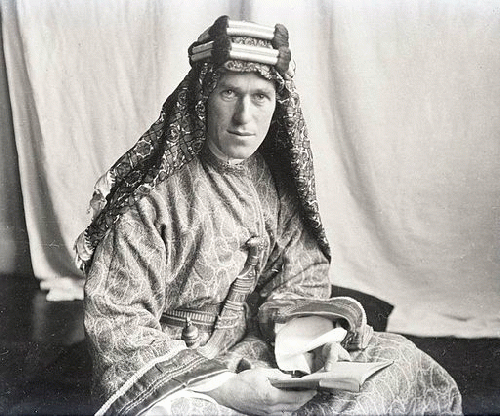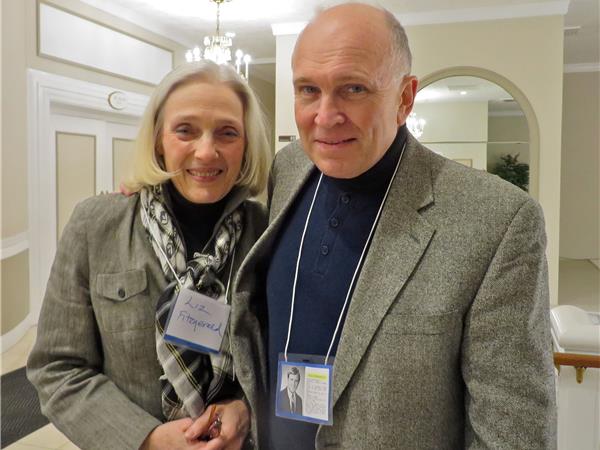The Grand Illusion of Imperial Power - 2 Part Series

Lieutenant Colonel Thomas Edward Lawrence (Lawrence of Arabia) 1919
(Image by Lowell Thomas, Author: Lowell Thomas (photographer)) Details Source DMCA
All men dream but not equally. Those who dream by night in the dusty recesses of their minds wake in the day to find that it was vanity: but those dreamers of the day are dangerous men for they act their dreams with open eyes, to make it possible. - British soldier T. E. Lawrence from Seven Pillars of Wisdom
Few Americans today understand how the United States came to be owned by a London-backed neoconservative/right-wing alliance that grew out of the institutional turmoil of the post-Vietnam era. Even fewer understand how its internal mission to maintain the remnants of the old British Empire gradually overcame American democracy and replaced it with a "national security" bureaucracy of its own design. We owe the blueprint of that plan to James Burnham, Trotskyist, OSS man and architect of the neoconservative movement whose exposition of the Formal and the Real in his 1943 The Modern Machiavellians justified the rise of the oligarch and the absolute rule of their managerial elite. But Americans would be shocked to find that our current political nightmare came to power with the willing consent and cooperation of President James Earl Carter and his National Security advisor Zbigniew Brzezinski; aided by intelligence agencies in Europe and the Middle East.
A straight line can be drawn between today's political hysteria and the 1970s era of right-wing Soviet hysteria as Russia stands accused of "meddling" in American democracy. The merits of those charges have been discussed in depth elsewhere. According to the dean of American intelligence scholars Loch K. Johnson as reported in the New York Times, the United States has done extensive meddling in other nation's elections.
And then there is that hidden "meddler" behind the meddling; Britain. The extent of British meddling in American politics - at least since - the beginning of the 20th century would shock even the most devout cheerleaders of ex-MI6 agent Christopher Steele and his "dirty dossier". In a case reminiscent of America's current hysteria over Russia, British intelligence even meddled with its own government back in the mid-1970s when right-wing elements of the military plotted a coup d' etat of Labor Prime Minister Harold Wilson based on information generated by their own disinformation campaign about Soviet influence. The 1917 Zimmerman telegram and the creation of the British Security Coordination in 1940 directly intervened in American politics on behalf of Britain. But the 1970 Creation of the Institute for the Study of Conflict (ISC) by British secret agent Brian Crozier marked a key turning point in the transformation of officially sanctioned propaganda.
As presented by Edward Herman and Gerry O' Sullivan in their 1989 study, The Terrorism Industry, "The London-based Institute for the Study of Conflict (ISC) provides an especially well-documented case study of the use of a purportedly 'independent' institute as a front for propaganda operations of hidden intelligence agency and corporate sponsors." The purpose of ISC was to give discredited right-wing, anti-Communist and anti-union cliche's in Britain the cover of legitimacy. The "Institute" got off to a quick start in the U.S. by forging an alliance with the National Strategy Information Center, NSIC a right-wing neoconservative think tank founded by Frank Barnett, William Casey and Joseph Coors in 1962. ISC's first major triumph came in collaboration with the ultra-right-wing Pinay Cercle when Crozier and his prote'ge' Robert Moss produced an ISC Special Report attacking the legitimacy of de'tente with the Soviet Union called European Security and the Soviet Problem. The study, financed by the Pinay group made no bones about its "Soviet problem" actually being the old "Russia problem" that European Imperialists had been hoping to solve since Napoleon's disastrous march on Moscow in 1812.
As a devoted acolyte of James Burnham, Crozier brought to his secret world of rightwing businessmen, intelligence, police and military officials a strategic plan to use the media to move the West's democracies to the ideological right by fabricating threats of Communist subversion. Determined to undermine de'tente, Antoine Pinay was so delighted with Crozier's double-speak he presented the study in person to President Nixon and Henry Kissinger and by 1975 the group was staged to make their move on Washington. Less than two months before the fall of Saigon, the US Committee of the ISC (USISC) was launched which would act as the parent body of the Washington Institute for the Study of Conflict (WISC).
In the vacuum created by Vietnam Crozier and Pinay's extremism was no longer viewed as extreme. Despite the public scandal over the CIA's use of Crozier's Forum World Features as a London-based fake news service, Washington elites were rolling out the red carpet to welcome them, including Zbigniew Brzezinski and George Ball. Under Ball's Chairmanship WISC appeared a veritable who's who of high-level ex-CIA, neoconservative and right-wing influencers. From Georgetown University came WISC's first President James Theberge whose books on Soviet influence in the Caribbean -- helped provide the pretexts for overthrowing Chile's legitimately elected leftist president Salvador Allende. And then there was Richard Pipes, the anti-Soviet history professor from Harvard University, who would soon be hand-picked to lead a neoconservative attack on the CIA known as Team B.
In the words of Lawrence J. Korb, a Senior Fellow at the Center for American Progress and assistant secretary of defense from 1981 to 1985, Pipes and the Team B were the real reason for the intelligence failures represented by 9/11 because of their biases and unbalanced judgement. But in the end the Team B view gained influence. With the appointment of fellow WISC member Zbigniew Brzezinski as President Carter's national security advisor, British intelligence agent Brian Crozier's plan to subvert the de'tente process with the Soviet Union was complete. Crozier's belief "[T]hat the entire security apparatus of the United States was in a state of near collapse," provoked yet another move to interfere in American politics. His solution was a secret off-the books "Private Sector Intelligence agency, beholden to no government, but at the disposal of allied or friendly governments for certain tasks which, for one reason or another, they were no longer able to tackle"" including "[S]ecret counter-subversion operations in any country in which such actions were deemed feasible." Brian Crozier and Zbigniew Brzezinski were of one mind when it came to disbelieving in "mutual coexistence" or power-sharing with the Soviet Union and Brzezinski's membership in WISC proved it. Thanks to WISC member Richard Pipes and the Team B, Brzezinski could now bring Britain's radical right-wing formula for social change right into the Oval Office.
Brzezinski devised a structure that channeled all executive decisions into two committees, the Policy Review Committee (PRC) and the Special Coordination Committee (SCC) chaired by him. Carter then elevated the national security advisor to cabinet level and the palace coup was complete. As recalled by the neoconservative author David J. Rothkopf in Charles Gati's 2013 book ZBIG, "It was a bureaucratic first strike of the first order. The system essentially gave responsibility for the most important and sensitive issues to Brzezinski."
Another operation initiated by Brzezinski in 1977 was the Nationalities Working Group (NWG), dedicated to inflaming ethnic tensions among the Islamic populations of the South Asia region. Brzezinski then continued on into nuclear policy where he altered the SALT structure and then rigged the negotiations against Secretary of State Cyrus Vance. With Brzezinski expanding nuclear targeting options from 25,000 to 40,000 and covert action teams sabotaging behind Soviet lines from early 1977 onward the message was clear; SALT and De'tente were getting ripped up as well as the very assumptions both were based on.
By 1978, Brzezinski's plan to use China as a weapon against the Soviets was playing out in Afghanistan. The April, 1978 Marxist coup against the King's cousin, Mohammed Daoud played into Brzezinski's "predictions" of a Soviet plan to incorporate Persia and South Central Asia into the Soviet sphere and ultimately take-over The Middle East. Vance rejected Brzezinski's argument. The coup had caught both the Soviets and the State Department by surprise and the coup leader, Hafizullah Amin raised doubts on both sides of the fence as an unpredictable agent provocateur. Amin had taken money from the CIA and headed up the Afghan Student Association at a time when it was being used as a CIA recruitment tool for future Third World leaders. Amin was now one of those leaders and Vance was sending a tough and savvy American Ambassador to Kabul named Adolph "Spike" Dubs to deal with him. The outcome would change the world and end in tragedy for all.
In an interview we conducted in 1993 with Selig Harrison - former Washington Post foreign correspondent and Carnegie Endowment Senior Associate - Ambassador Dubs came to Kabul in the summer of 1978 with a mission: Bring Afghan leader Hafizullah Amin over to the American side and keep the Russians out. President Carter's national security advisor, Zbigniew Brzezinski had engineered a grander mission: Pressure Amin to draw the Soviets in through destabilization and then keep them tied down and give them their own Vietnam. By the time Ambassador Dubs arrived in Kabul, Afghanistan had become ground zero for a long anticipated anti-Soviet destabilization campaign organized by Brzezinski and carried out by an off the books intelligence operation known as the Safari Club. The "club" represented the true essence of the CIA ethos; an autonomous covert action organization with global reach, beyond the jurisdiction of American oversight and responsible to no one. A spinoff of the right-wing Pinay Cercle, the Safari Club had been active informally in the Middle East and Africa for years. But the club found its true calling following Watergate and the Church Committee hearings on 30 years of CIA coups, cover-ups and assassinations. Managed by France's Count Alexandre de Marenches chief of French external intelligence, the club included the Shah of Iran, King Hassan II of Morocco, President Anwar al-Sadat of Egypt, Kamal Adham, head of intelligence for Saudi Arabian King Faisal and Iraqi strongman Saddam Hussein. More to the point, by 1976 the Safari Club had become the real CIA, covertly funded by Saudi Arabia's chief of intelligence Kamal Adham through the Bank of Commerce and Credit International (BCCI) and run out of the U.S. embassy in Tehran.
Copyright - 2018 Fitzgerald & Gould All rights reserved
(Note: You can view every article as one long page if you sign up as an Advocate Member, or higher).





